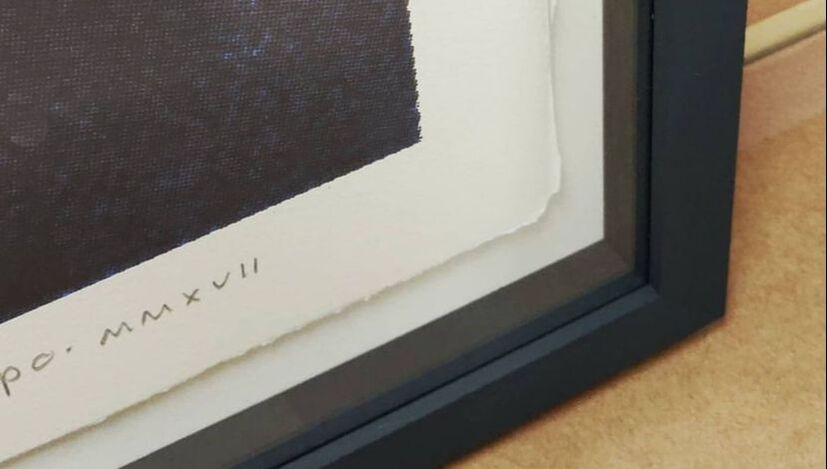Framing & Pricing Guide
Framing a picture for the first time? It can be tricky, so here's a little beginner's guide to help you out!
A well-chosen frame can completely change how you perceive a piece. Everything from the type, size, and color of the frame to the way it's mounted can unlock its hidden potential, highlighting selected features and completing the overall look.
Furthermore, framing is also about protecting your item from dust, scratches, and other possible damage. While some items, like oil paintings, can be hung as they are, more fragile works on paper would benefit from glazing and a sturdy frame.
A well-chosen frame can completely change how you perceive a piece. Everything from the type, size, and color of the frame to the way it's mounted can unlock its hidden potential, highlighting selected features and completing the overall look.
Furthermore, framing is also about protecting your item from dust, scratches, and other possible damage. While some items, like oil paintings, can be hung as they are, more fragile works on paper would benefit from glazing and a sturdy frame.
|
Mounts (also known as mats)
Often referred to as 'the border,' a mount isn't necessary all the time, and pieces like posters are often framed without it or 'to the edge.' However, original artworks on paper or photographs often look their best when mounted. In addition to highlighting the artwork, a mount also provides physical distance and prevents the artwork from sticking to the glass. This is especially important with glossy finish photos or artworks containing oil-based paints and inks. We only use acid-free mount cards and fastening materials in our process. Please contact us for the full selection of mount colours available. |
|
Most commonly used mounting technique is called Window mounting - when a beveled edge ‘window’ is cut into the board to show the artwork underneath it. There’s no hard-and-fast rule as to how wide a mount should be in relation to the artwork as it depends on the size and other features of the piece but as a general rule, your mount should be at least 1.5 times as wide as your frame. If the mat is smaller than the frame, you run the risk of the artwork appearing stuffed into the frame. As a guide, we will often use 4-6cm wide margin on an A3 piece.
|
|
Another popular way to mount the piece is Surface mounting. In this way the edge of the paper is left exposed and the mount card serves as a base. This is usually done when the edge of the paper is torn or is irregular in another interesting way. (Please note that in some cases, an inner frame (known as a fillet) may be required to keep the glass off the paper).
Other types of mounting we offer include Step mount, Surface-window, Float and Shadow mounting. |
|
Frames (mouldings)
Usually there are many possible ways of framing a piece depending on what features you want to underline within it or where in the room it is going. Here’s couple of notes when choosing the right frame: 1. The frame width generally should be skinnier than the mount used to create a bit of variance and some space for the picture. 2. Select the best frame for the piece instead of matching another frame. Sometimes clients will want to match an existing frame but if the exact match isn’t available, the general advice is to go with something that will compliment the artwork and the interior rather than opting for a ‘close enough’. If the match falls a little short, it simply won’t look right. |
|
|
Glass
To protect your piece from the dust scratches and other environmental factors we use glazing. The most commonly used is regular 2mm picture glass that naturally offers approximately 45% UV protection. Besides it, with a variation in price, we also stock:
|
|
Artworks on Board and Canvas
Some artworks don’t require mounting or glazing. For example, an oil or acrylic painting on canvas often looks it’s best with a well matched frame around it and nothing else. In addition to our usual mouldings, we also offer ‘Tray’ or ‘Open’ frames that are perfectly suited for artwork that doesn’t require glazing and provide an elegant, minimalist finish to the piece. To bring the artwork to the top of the frame, sometimes we need to use 'a Float'. It's an additional frame that hides behind the artwork, creating an illusion of it floating (especially common with artwork on board). |
(A very rough) Guide to Pricing
|
Picture framing is a complex process with many variables. The final price of the job will depend on factors such as the final size, materials used, and any special manual labor required (e.g., hand-finishing, painting of the frame, or waxing).
Below is a rough guide to give you an idea of what you can expect to pay, based on the size of the picture, while utilizing some of our popular and affordable options. In addition to the factors mentioned, the price includes backing, regular picture glass, acid-free barrier board, and hangers. |
Framing Price Guide
* Please note that this information is strictly for illustration purposes only and is subject to change. Prices include VAT.
|
Framing of Sport ShirtFraming of Football, Rugby and similar shirts start at £155.
This is based on basic black frame, surface mount, no fillets, regular glass of a size of around 80x90cm. |







